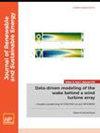Ultra-short-term wind power forecasting based on feature weight analysis and cluster dynamic division
IF 1.9
4区 工程技术
Q4 ENERGY & FUELS
引用次数: 0
Abstract
Accurate and reliable ultra-short-term wind power forecasting (WPF) is of great significance to the safe and stable operation of power systems, but the current research is difficult to balance the prediction accuracy, timeliness, and applicability at the same time. Therefore, this paper proposes a ultra-short-term WPF model based on feature weight analysis and cluster dynamic division. The model introduces an analytic hierarchy process and an entropy weight method to analyze the subjective and objective weight of the influencing features of wind power, respectively, then the subjective and objective weight ratio is determined by the quantum particle swarm optimization (QPSO) algorithm to obtain a more reasonable comprehensive weight of each feature. On this basis, it uses the K-Medoids algorithm to dynamically divide the wind power clusters into class regions by cycles. Then, the class region is used as the prediction unit to establish the TCN-BiLSTM model based on temporal convolutional networks (TCN) and bi-directional long short-term memory (BiLSTM) for training and prediction and optimizes the hyper-parameters of the model by the QPSO algorithm. Finally, the regional predictions are summed to obtain the final ultra-short-term power prediction. In addition, in order to verify the performance of the model, the actual operation data of a power field in Xinjiang, China, are selected for the example validation. The results show that the proposed model can ensure the prediction accuracy while minimizing the training time of the model and outperforms other existing methods in terms of prediction accuracy, timeliness, and applicability.基于特征权重分析和聚类动态划分的超短期风电预测
准确可靠的超短期风功率预测(WPF)对电力系统的安全稳定运行具有重要意义,但目前的研究难以同时兼顾预测精度、时效性和适用性。因此,本文提出了一种基于特征权重分析和聚类动态划分的超短期 WPF 模型。该模型引入层次分析法和熵权法,分别对风电影响特征的主客观权重进行分析,然后通过量子粒子群优化(QPSO)算法确定主客观权重比,从而得到各特征较为合理的综合权重。在此基础上,利用 K-Medoids 算法将风电簇按周期动态划分为类区域。然后,以类区域为预测单元,建立基于时序卷积网络(TCN)和双向长短时记忆(BiLSTM)的 TCN-BiLSTM 模型进行训练和预测,并通过 QPSO 算法优化模型的超参数。最后,将区域预测结果相加,得到最终的超短期功率预测结果。此外,为了验证模型的性能,还选取了中国新疆某电场的实际运行数据进行实例验证。结果表明,所提出的模型既能保证预测精度,又能最大限度地减少模型的训练时间,在预测精度、时效性和适用性方面均优于其他现有方法。
本文章由计算机程序翻译,如有差异,请以英文原文为准。
求助全文
约1分钟内获得全文
求助全文
来源期刊

Journal of Renewable and Sustainable Energy
ENERGY & FUELS-ENERGY & FUELS
CiteScore
4.30
自引率
12.00%
发文量
122
审稿时长
4.2 months
期刊介绍:
The Journal of Renewable and Sustainable Energy (JRSE) is an interdisciplinary, peer-reviewed journal covering all areas of renewable and sustainable energy relevant to the physical science and engineering communities. The interdisciplinary approach of the publication ensures that the editors draw from researchers worldwide in a diverse range of fields.
Topics covered include:
Renewable energy economics and policy
Renewable energy resource assessment
Solar energy: photovoltaics, solar thermal energy, solar energy for fuels
Wind energy: wind farms, rotors and blades, on- and offshore wind conditions, aerodynamics, fluid dynamics
Bioenergy: biofuels, biomass conversion, artificial photosynthesis
Distributed energy generation: rooftop PV, distributed fuel cells, distributed wind, micro-hydrogen power generation
Power distribution & systems modeling: power electronics and controls, smart grid
Energy efficient buildings: smart windows, PV, wind, power management
Energy conversion: flexoelectric, piezoelectric, thermoelectric, other technologies
Energy storage: batteries, supercapacitors, hydrogen storage, other fuels
Fuel cells: proton exchange membrane cells, solid oxide cells, hybrid fuel cells, other
Marine and hydroelectric energy: dams, tides, waves, other
Transportation: alternative vehicle technologies, plug-in technologies, other
Geothermal energy
 求助内容:
求助内容: 应助结果提醒方式:
应助结果提醒方式:


